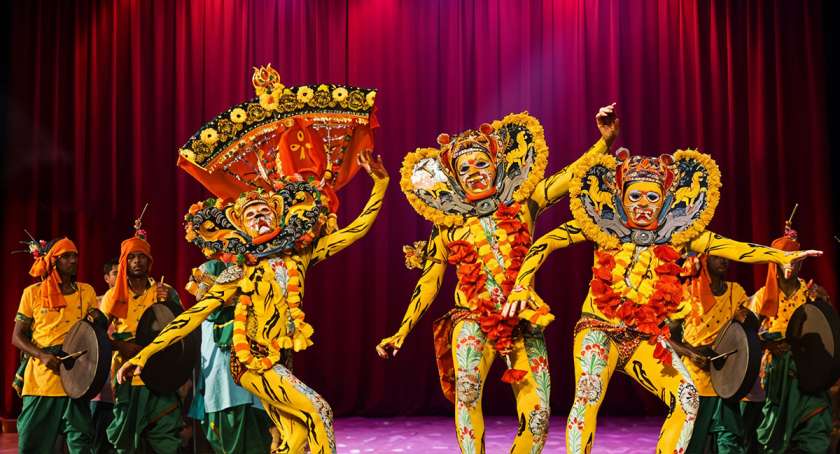Bagha Nacha or Tiger Dance
India has diverse cultures, rich traditions, and vibrant festivals, each with unique charm. Among the many traditional dance forms, Bagha Nacha, also known as the Tiger Dance, is a spectacular folk dance that embodies energy, enthusiasm, and profound cultural significance. Predominantly performed in the Indian state of Odisha, this dance is a mesmerizing display of art, devotion, and community spirit. With its bold tiger-inspired body painting, rhythmic drumming, and dynamic movements, Bagha Nacha captivates audiences and keeps the age-old tradition alive.
This unique dance form is a medium of entertainment and a spiritual expression that showcases the fearless nature of the tiger. The performers, painted to resemble the majestic beast, embody its strength and grace as they move through the crowds. The dance, often accompanied by the beats of traditional drums, is essential to Odisha’s religious and cultural celebrations.
Spiritual Essence and Cultural Significance
Bagha Nacha has its roots in Odisha folklore and religious practices. People believe this dance originated centuries ago as a ritual to honor Hindu deities, particularly Goddess Durga and Lord Shiva. The dance is an offering of gratitude and a demonstration of courage, strength, and agility, reflecting the attributes of a tiger.
Performers traditionally showcase this dance during Dussehra and Durga Puja festivities. This dance symbolizes the power of Goddess Durga, as artists often depict her riding a lion or tiger while slaying the demon Mahishasura. The dance is a tribute to her divine power, representing the triumph of good over evil. Bagha Nacha is also a significant part of local temple festivals and processions, where performers take to the streets, entertaining and blessing the devotees.
Besides its religious importance, Bagha Nacha is vital in fostering community bonding. Villages and towns organize performances, with locals participating in the dance, music, and celebrations. The art form is passed down through generations, ensuring this rich cultural heritage remains intact.
Art of Transformation through Body Painting and Costume Design
One of the most fascinating aspects of Bagha Nacha is its elaborate body painting. Unlike other dance forms that rely on heavy costumes and masks, Bagha Nacha performers undergo an artistic transformation, where their bodies become living canvases of vibrant colors and intricate patterns.
- The artists painted the dancer’s torso, arms, and face yellow, orange, black, and white to resemble a tiger’s stripes.
- Artists skillfully create realistic tiger features, including detailed stripes and fierce facial expressions.
- Some performers even add whiskers and fangs to enhance the wild appearance.
- The painting process can take several hours, requiring patience and precision.
- The paint is usually made from natural dyes and organic colors to avoid skin irritation and ensure a lasting effect.
The dancer’s transformation into a tiger is a crucial part of the performance, adding an element of realism that makes Bagha Nacha stand out from other traditional dances. The painted performers move through the streets, engaging with spectators, creating a thrilling and visually stunning spectacle.
Dance Performance with Movements and Music
The performance of Bagha Nacha is as thrilling as its appearance. The dancers showcase powerful, energetic movements that mimic the behavior of a tiger. The performers leap, prowl, and crouch like majestic animals, creating an illusion of real tigers moving through the crowd.
Key Elements of the Dance:
- Stalking and Pouncing: Performers start with slow, stalking movements, imitating a tiger hunting its prey.
- Leaps and Jumps: The dance incorporates high-energy jumps and quick turns, showcasing the dancer’s agility.
- Growling and Roaring Sounds: Some dancers vocalize tiger-like growls to enhance the authenticity of the act.
- Interaction with the Audience: Dancers engage with spectators, playfully scaring and amusing them, making it an interactive experience.
- Synchronization with Drums: Traditional drummers set the rhythm of the dance by beating large drums (known as dhols) with intense vigor, matching the tempo of the performance.
The dancers’ coordinated movements and fearsome appearance create a mesmerizing experience, leaving audiences in awe. The performance’s fast-paced action and immersive nature make it a highlight of any festival or cultural event.
Festivals and Occasions Featuring Bagha Nacha
Performers present Bagha Nacha multiple times, drawing large crowds who witness the grandeur of this folk art. Some of the most notable events that showcase this dance include the following:
1. Durga Puja and Dussehra
- One of the biggest festivals in Odisha, where performers showcase Bagha Nacha as an offering to Goddess Durga.
- Dancers parade through streets, temples, and festival grounds, entertaining devotees.
2. Kartik Purnima
- Celebrated during the full moon in the Hindu month of Kartik, this festival sees Bagha Nacha performances near riverbanks and temples.
3. Local Fairs and Processions
- Many villages and towns in Odisha organize cultural fairs where Bagha Nacha is a significant attraction.
- Performers also showcase it during temple inaugurations and religious processions.
Final Thoughts
Bagha Nacha is more than just a folk dance; it symbolizes strength, artistry, and devotion. With its vibrant tiger body painting, electrifying movements, and pulsating drum beats, it continues to mesmerize audiences. As we move towards modernization, supporting and celebrating traditional art forms like Bagha Nacha is crucial, ensuring that this roaring legacy remains alive for generations.
So, the next time you visit Odisha during Durga Puja or a local fair, witness the spectacular Bagha Nacha – a dance that embodies the tiger’s spirit!


